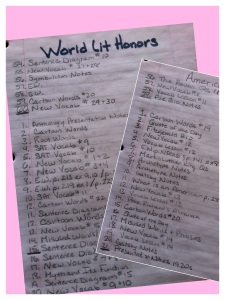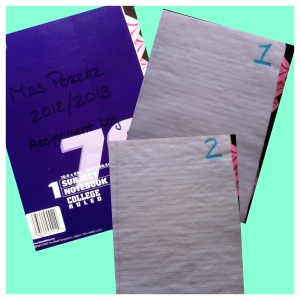The beginning of the school year is around the corner, and with it is the dread of the stack of assignments. This is what my life looked like before I started having kids use a 70-page spiral notebook in class:
I have to look at grammar and vocabulary and notes from the movie and the book summary and the study guide questions. The assignments seem endless and then I ask kids to answer some questions at home and now the due date arrives. I secretly hope that most of the kids will not turn in the responses, but they do and now there is a stack of 165 papers to check off, record, and return. This cycle does not end because tomorrow the next assignment is due and that is 165 more papers and I did not grade yesterday’s work because my son was sick and I took him to see his doctor, then I had to make dinner, then I had to respond to parent and administrator emails before making my lunch for the next day only to begin the cycle again.
I have reduced the number of loose papers turned in to me by two-thirds by using a 70-page spiral notebook.
Here is how it works:
Begin the year by letting kids know to add a 70-page spiral notebook to their school supplies list. Older students, grades 10-12, usually find a way to obtain a notebook by the second day of school while the younger kids, grades 9 and below, have trouble obtaining a notebook. I usually supply about 20% of my ninth grade students with the first 70-page spiral notebook of the year. Our class typically uses three notebooks per year.
On the second day of school I go over the set up.
- Student name, period, and teacher are written outside and inside of the front cover. The first two pages are blank. Students will use these pages for a personal table of contents.
- Students will number each page in the top right-hand margin. Numbering the pages seems to be a bit of a task, so I demonstrate with my own notebook how to write page numbers on the front of each page only, not on the back.
Try to modify all assignments to fit in the notebook setup. Instead of copying handouts, try projecting study questions, graphic organizers, and class notes that will be copied down or answered on a specific page in the notebook. Homework and classwork such as grammar exercises, vocabulary exercises, documentary notes, and short journal entries is done in the notebook.
- As we come to a new assignment it is assigned the next available page in the notebook and all students should have the same assignment on the same page.

I keep a running log of the page numbers and the assignment titles in my notebook which students are welcome to look at to find what goes on a blank page in their notebook. I keep all different courses in one master notebook with a tab separating each course. This log is especially helpful for absent students on their return.
For example, I have a daily assignment called Cartoon Words. The students are to come into the classroom, sit down, and begin copying the Cartoon Word of the day. I ask everyone to put this on page 1. I demonstrate how to create a chart on page 1 so that they can fit all ten daily words on one page. Now everyone in the class has Cartoon Words on page 1. What goes on page 2? Anything you want. After the Cartoon Word, I may ask students to grab a grammar book and work on an exercise. I will tell students to use page 2 for the grammar exercise. Next, we might work on vocabulary. I will tell students to use page 3 for the vocabulary exercise.
- Let kids know a few days before notebook collection so that they have time to work on any blank pages. Consider making the grading an easy ten points per page, but perhaps allow a five-point page for half of the effort. I try to collect notebooks when the students have completed between fifteen and twenty pages. I grade for completion only. I have tried to go over each page to check for correctness or grammar, but it is overwhelming and time consuming. I try to get the notebooks back the next day so that the class can work on the next day’s assignments.
There are a few negatives to this system.
- Some students will copy another student’s notebook, however; if I sent a worksheet home that will be copied too, hence my check only for completion. After many years of sticking to principle, I have learned to pick my battles and this is not a winning battle even if I receive 165 loose pages per day. I have used date stamps or cute teacher stamps to try to curb the copying as I walk around the room, but some assignments do not allow me to give this instant check.
- Some students simply cannot afford to purchase a notebook. I try to get a few dozen notebooks at Back to School sales and give them discreetly to students who cannot purchase one. If I have no notebooks to give I staple twenty pages of notebook paper together and that becomes the notebook.
- Someone always “loses” his notebook. There are not many, but there are always one or two “lost” notebooks. In these cases I excuse the assignment the first time it happens, but the second time it is a missing assignment and counts against the grade. Students quickly catch on that “losing” the notebook or letting someone “borrow” their notebooks is a bad idea, especially on a due date or if I allow open notes on a test day. Too bad. Late notebooks are late and there is no makeup for not having notes in class on test day.
There are quite a few more positives to this system.
- It allows me to schedule a time to collect notebooks that does not interfere with other assignments or classes.
- It keeps the kids responsible and working during class time, especially as I cruise through the room with my teacher stamps.
- All of the assignments are in one place, and no one accuses me of losing an assignment.
- My assignment pile is reserved for in-class essays or something that does not work well in the notebook.
- There is no late work or make-up work. Everything that goes in the notebook can be done at home with the textbook. If I have given class notes and the student was absent, I give him a website to take notes on his own or tell him to ask a friend if he can see the class notes—I know, back to the cheating issue.
- We can pick up in the same place where we left off the day before without the fuss of looking for yesterday’s notes.
- The kids learn a valuable note-taking lesson. They quickly learn to use a different notebook for each class and how to organize their notes by date or page number. The notebook can be a valuable tool even in college.
The best thing about the notebook is that a teacher can make it as simple or complicated as she would like. I know of some teachers who ask students to tape handouts or charts onto pages in the notebook. If you choose to have students add items to the notebook pages, I recommend using tape and not staples. The staples cut into the other pages and make the writing surface of the other pages lumpy and uneven.
Please let me know how this works for you. I am interested to know about the modifications you have made for your classroom 🙂
